While scorching heat can wilt your garden, a few smart tricks can keep it lush. Start by watering early, around 6 a.m., to beat evaporation and give plants a full inch of moisture. This timing, before the sun peaks, guarantees roots soak up every drop. Curious about more ways to protect your plot from the sizzle? Stick around for practical tips to keep things green.
Contents
Watering Early Morning
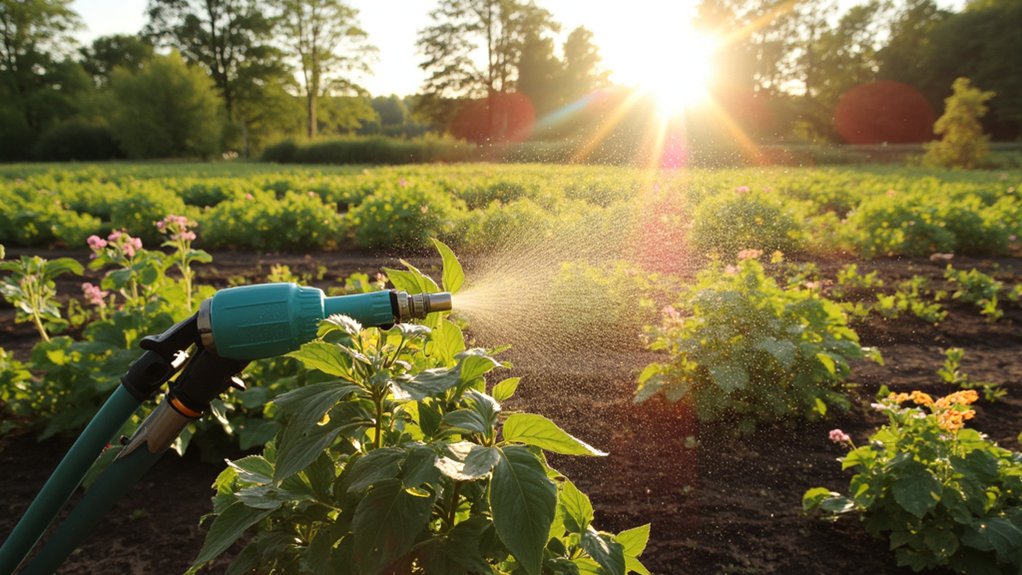
While you might be tempted to water your garden whenever you’ve got a free moment, timing is everything. Stick to early morning, ideally between 5 and 9 a.m., when it’s cooler. This way, your plants soak up water before the sun gets intense.
Why early? Watering at this time cuts down on evaporation, ensuring every drop counts. Aim to give your garden about 1 inch of water per session, using a soaker hose or drip system for even distribution. Check the soil; if it’s damp 2 inches down, you’re good.
Don’t wait until midday or evening. Morning watering helps leaves dry out, preventing pesky fungal issues. Grab that hose before breakfast, and watch your garden thrive with minimal fuss.
Mulching Retains Moisture
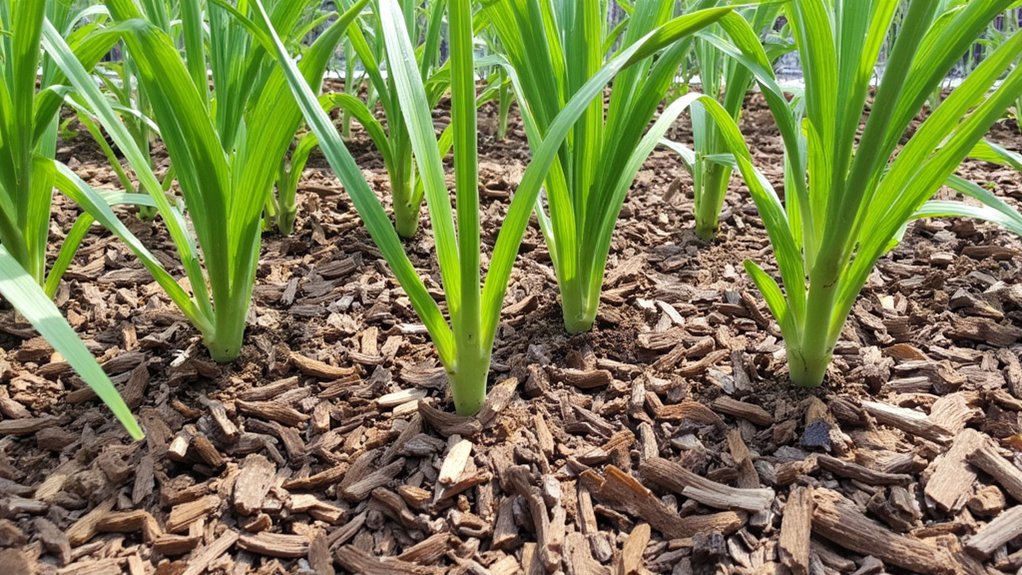
Let’s talk about mulching, a simple trick to keep your garden’s moisture locked in tight. You’ve watered your plants, but heat can steal that hydration fast. Mulch acts like a barrier, slowing evaporation and keeping soil cool.
Grab organic mulch, like wood chips or straw, and spread a 2- to 3-inch layer around your plants. Don’t pile it against stems, though; leave a 1-inch gap to prevent rot. This thickness blocks weeds too, saving you extra work.
Apply mulch after watering, ideally in the early morning, to trap existing moisture. Check it every few weeks, adding more if it thins out below 2 inches. With this, you’re giving your garden a fighting chance against scorching days.
Shade Cloth Protection
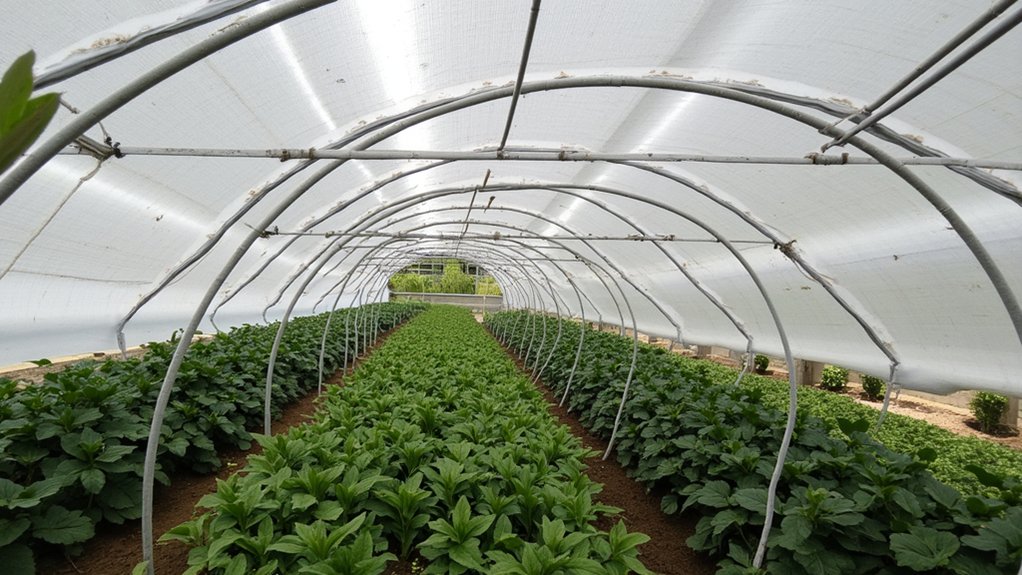
Ever thought about shielding your garden from harsh sun rays? Well, shade cloth protection’s your answer, and it’s super easy to set up. This lightweight fabric cuts down intense sunlight, usually by 30-50%, keeping plants cooler. You’ll save them from wilting under that brutal summer heat.
Grab a shade cloth with a density matching your needs—denser for delicate greens, lighter for tougher crops. Measure your garden area, say 10 by 12 feet, and cut the cloth accordingly. Secure it over hoops or a simple frame using zip ties or clips, ensuring it’s taut. Check it weekly for tears or sagging, fixing issues pronto. With this setup, you’re giving your garden a fighting chance against scorching days, no sweat!
Choose Heat-Tolerant Plants
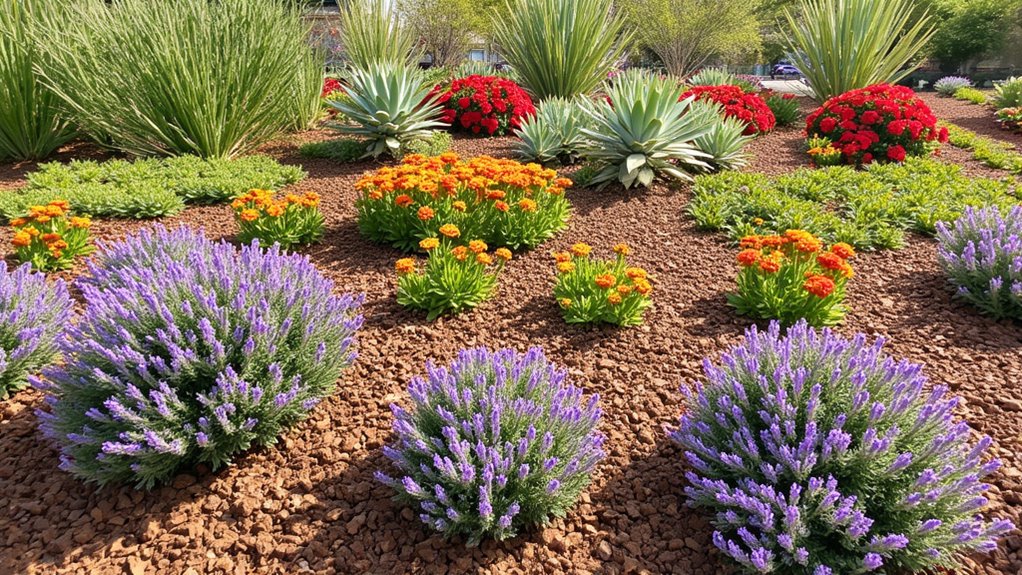
Hey, beyond just shielding your garden with shade cloth, you can also pick plants that naturally handle the heat. Some species, like lavender and succulents, thrive in scorching temps. They’re built for it, so you won’t stress over wilting leaves.
Start by researching heat-tolerant varieties suited to your zone, like zinnias or portulaca. Check local nurseries for advice on what grows best. Plant them in early spring, spacing them 12-18 inches apart for good air flow. This prevents overcrowding and reduces heat stress.
Don’t forget to mix in perennials like yarrow, which can take full sun. Group them in beds facing south for max exposure. With these choices, you’ll build a garden that laughs at summer’s worst heat waves. Stick to these, and watch ‘em flourish!
Monitor Soil Moisture
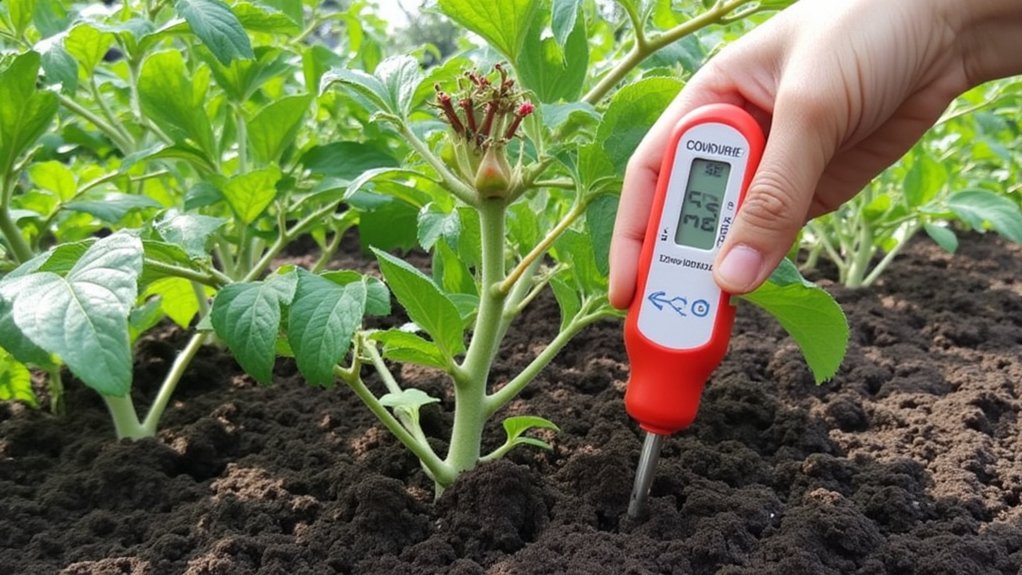
Many gardeners overlook soil moisture, but it’s a key factor in keeping your plants healthy. During hot weather, you’ve gotta check it daily. Dry soil can stress plants fast, so don’t assume rainfall’s enough.
Stick your finger about 2 inches into the soil near plant roots. If it feels dry, it’s time to act. Use a moisture meter for precision, aiming for a reading between 40-60% for most plants. Check in the early morning to get an accurate sense of overnight levels.
Don’t guess—set a reminder on your phone to monitor every day. Look at different garden spots, since sandy areas dry out quicker than clay. Keep a small notebook to track patterns. This way, you’ll prevent wilting before it starts.
Avoid Midday Watering

After checking soil moisture, let’s focus on when you’re watering your garden. Timing’s vital, especially in hot weather, so don’t just water anytime. Avoid midday watering, between 10 a.m. and 2 p.m., when the sun’s strongest. The heat causes water to evaporate fast, leaving your plants thirsty.
Instead, aim for early morning, ideally before 8 a.m., when it’s cooler. This lets water soak into the soil, reaching roots before evaporating. If mornings don’t work, try late afternoon, around 4 p.m. or later, to minimize loss. Just make sure leaves dry before night to prevent mold.
Stick to this schedule, and you’ll maximize every drop. Watch your garden thrive with less waste, even in scorching heat. Keep it simple, and stay consistent!
Use Drip Irrigation
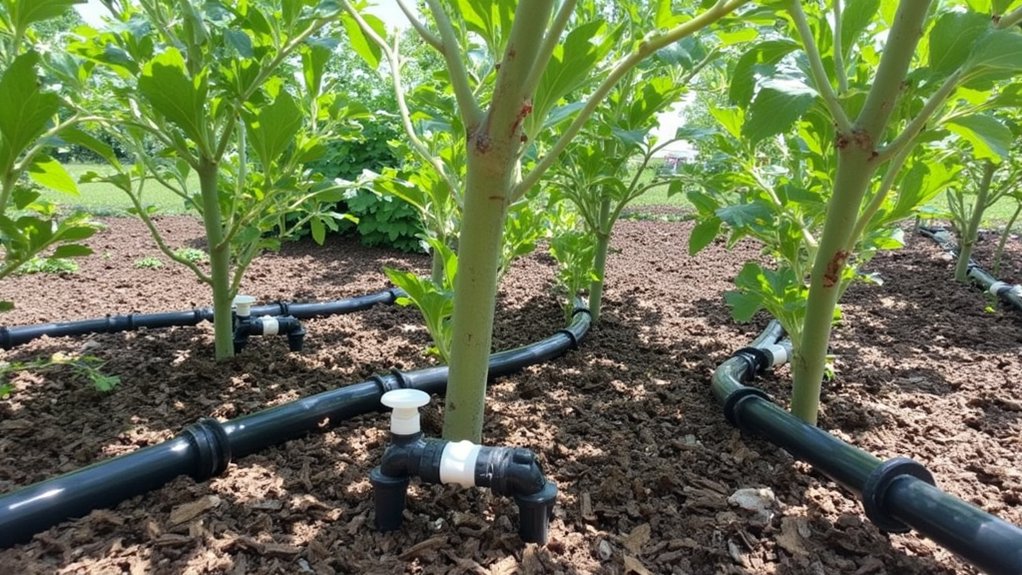
While timing your watering helps a lot, let’s talk about a game-changer for your garden: drip irrigation. This system delivers water straight to the roots, saving you time and effort. It’s efficient, too, cutting down on waste compared to sprinklers.
Set up a drip irrigation kit with hoses and emitters, spacing them about 12 inches apart near plant bases. Connect it to a timer, programming it to run for 30 minutes early in the morning. This guarantees deep watering without evaporation, keeping soil moist.
Check the system weekly for clogs or leaks, and adjust emitters if plants grow larger. You’ll notice healthier roots with less hassle. Trust me, once you’ve tried drip irrigation, you won’t go back to old methods.
Prune Heat-Stressed Plants
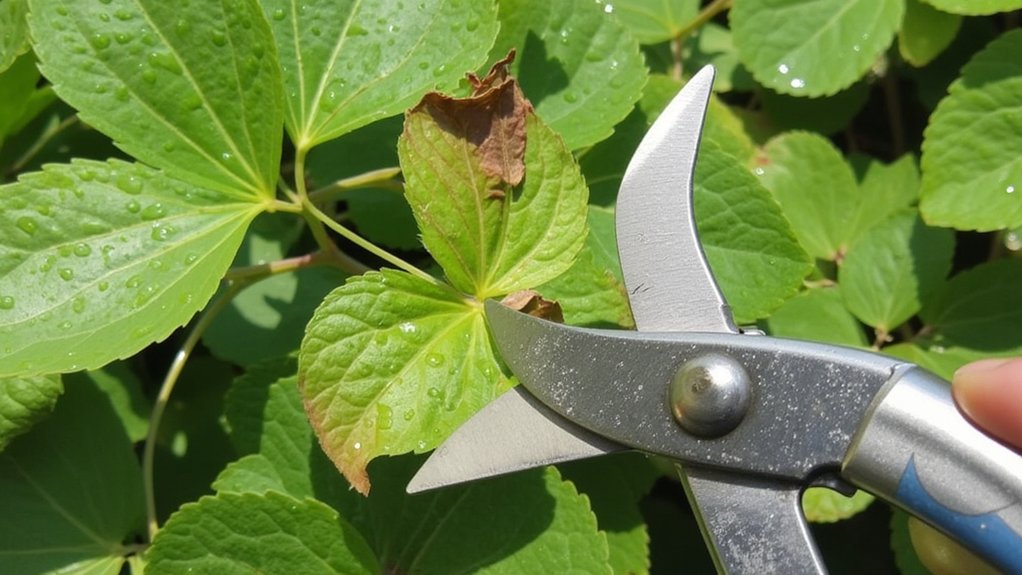
Hey, let’s shift gears from watering tricks to tackling another garden task: pruning heat-stressed plants. Hot weather can zap your plants’ energy, leaving them wilted or damaged. Don’t worry, though; you’ve got this!
Start by grabbing clean, sharp pruning shears—dull ones can harm plants. Look for dead, yellowed, or scorched leaves and stems, especially on shrubs and perennials. Cut these off at the base, about ¼ inch above a healthy bud or node, to encourage new growth.
Next, check for overcrowded branches that block airflow; thin them out. Prune in the early morning, before the sun’s peak heat, to avoid extra stress. Dispose of clippings to prevent pests. With these steps, you’ll help your garden bounce back fast!
Add Compost Regularly
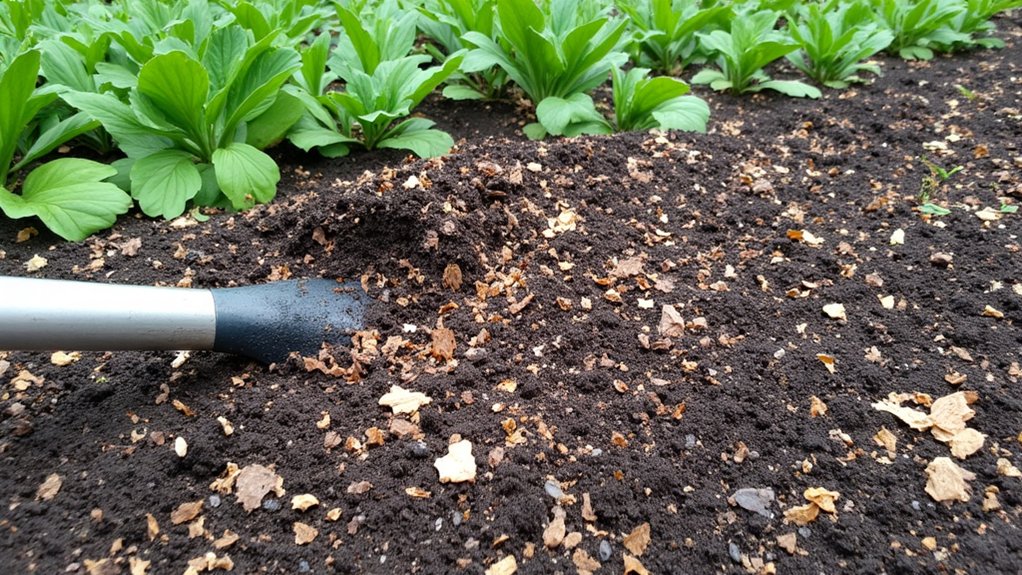
Three key words can transform your garden’s health: add compost regularly. You’ve gotta nourish your soil, especially in hot weather, when nutrients deplete fast. Compost adds organic matter, boosts moisture retention, and feeds plants naturally. So, don’t skip this step!
Start by collecting kitchen scraps—think vegetable peels, coffee grounds, and eggshells. Avoid meat or dairy, as they attract pests. Every two weeks, spread a 2- to 3-inch layer of compost over your garden beds, working it into the top 6 inches of soil with a shovel. This guarantees roots access the goodies.
Check your compost pile weekly, turning it to speed decomposition. Keep it moist, not soggy, about like a wrung-out sponge. You’ll see healthier, stronger plants in no time!
Harvest Crops Promptly
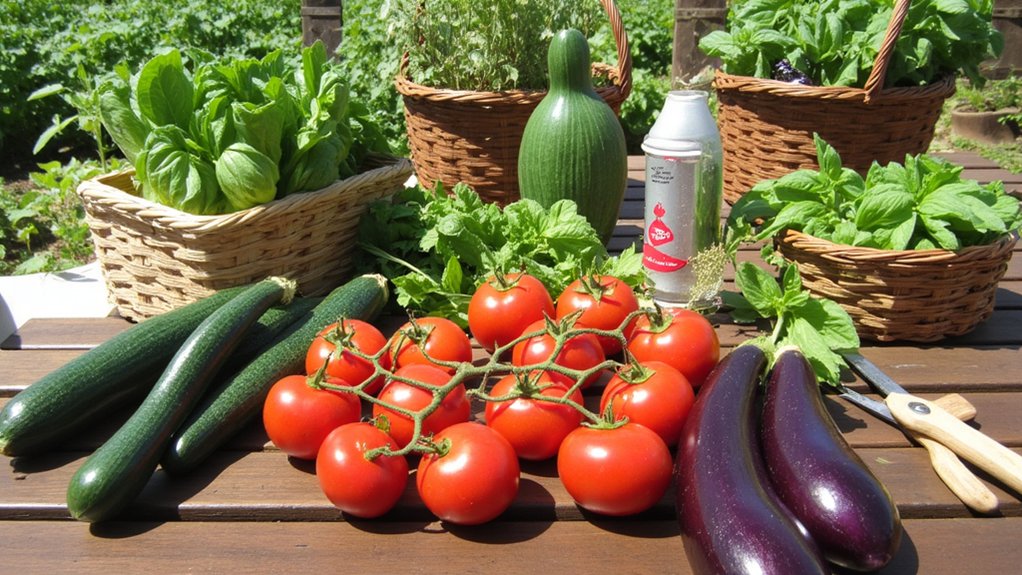
Let’s shift gears from enriching your soil to reaping the rewards of your hard work. Harvesting crops promptly, especially in hot weather, keeps your garden thriving. Don’t let ripe veggies linger; they’ll spoil fast under the sun.
Check your plants daily, ideally in the early morning before heat peaks. Look for ripe tomatoes when they’re fully red, or zucchini at 6-8 inches long. Snip herbs like basil before they flower, ensuring fresh growth. Waiting too long invites pests or overripening, wasting your efforts.
Use a sharp knife or scissors to cut, not pull, delicate produce. Store harvests in a cool spot right away, within 30 minutes if possible. This timing preserves flavor and nutrients. Keep at it, and your garden stays productive!
